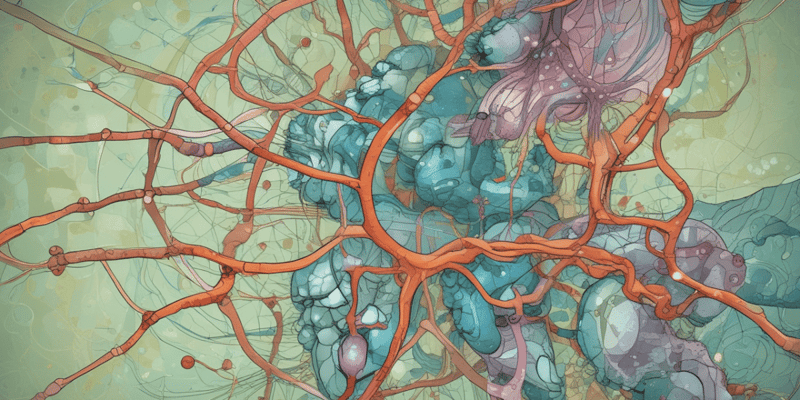10 Questions
What is the effect of nitroglycerine on blood vessels?
It relaxes blood vessels
Which of the following is NOT a target of NO in the immune system?
Autonomic nerves
What is the effect of ANP on the body?
It has a natriuretic and vasodilator effect
How does ANP bind to its receptor?
It binds to a G-protein-coupled receptor (GPCR)
What is the effect of cGMP on visual signal transmission?
It amplifies the visual signal
What is the role of guanylate cyclase in ANP-mediated signal transmission?
It increases cGMP
What is the effect of CO on target cells?
It stimulates guanylyl cyclase
What is the role of transducin in visual signal transmission?
It binds to GTP and activates guanylate cyclase
What is the effect of NO on the heart muscle?
It reduces oxygen requirement
What type of receptor is the rhodopsin receptor?
G-protein-coupled receptor (GPCR)
Study Notes
Cell Signaling
- All cells receive signals from their surroundings and respond to signals to meet the needs of the organism as a whole.
- Signaling molecules and their receptors regulate the behavior of each cell.
Signaling Process
- Recognition of signal: signaling molecules bind to their receptors.
- Transduction: binding of signaling molecules to their receptors initiates a series of intracellular reactions that regulate cell behavior.
- Response: modification of cell behavior.
Overview of Cell Signaling
- Stage One: Reception - signaling molecule binds to the specific receptor protein.
- Stage Two: Transduction - second messengers carry the original exterior signal to the interior of the cell.
- Stage Three: Response - activation of cellular response.
Signaling Molecules
- Types of signaling molecules:
- Proteins
- Peptide hormones (e.g. insulin, glucagon)
- Amino acids (e.g. epinephrine, histamine)
- Nucleotides
- Steroid hormones (e.g. sex hormones, corticosteroids)
- Thyroid hormone
- Vitamin D3
- Retinoic acid
- Fatty acid derivatives (e.g. prostaglandin, prostacyclins)
- Gases (e.g. Nitric Oxide, CO)
Modes of Cell Signaling
- Signaling with secreted molecules
- Signaling with molecules embedded in the membrane
- Contact-dependent signaling (juxtacrine signaling)
- Autocrine signaling: cells produce signals to which they also respond.
Types of Signaling
- Endocrine signaling: signaling molecules are secreted into the bloodstream and carried to target cells.
- Paracrine signaling: secreted molecules act as local mediators, affecting only cells in the environment of the signaling cell.
- Autocrine signaling: cells produce signals to which they also respond.
- Synaptic signaling: nerve cells extend long processes to contact target cells, secreting neurotransmitters.
Examples of Signaling
- Atrial natriuretic peptide (ANP) is synthesized in muscle cells located in the atrium of the heart and has natriuretic and vasodilator properties.
- Nitroglycerine is converted to NO, which relaxes blood vessels, increasing blood circulation and reducing oxygen requirement of the heart muscle.
- Carbon monoxide (CO) acts as an intercellular signal, stimulating guanylyl cyclase.
This quiz covers cell signaling in medical biology, including signaling molecules and their receptors, and how they regulate cell behavior to meet the needs of the organism.
Make Your Own Quizzes and Flashcards
Convert your notes into interactive study material.
Get started for free



